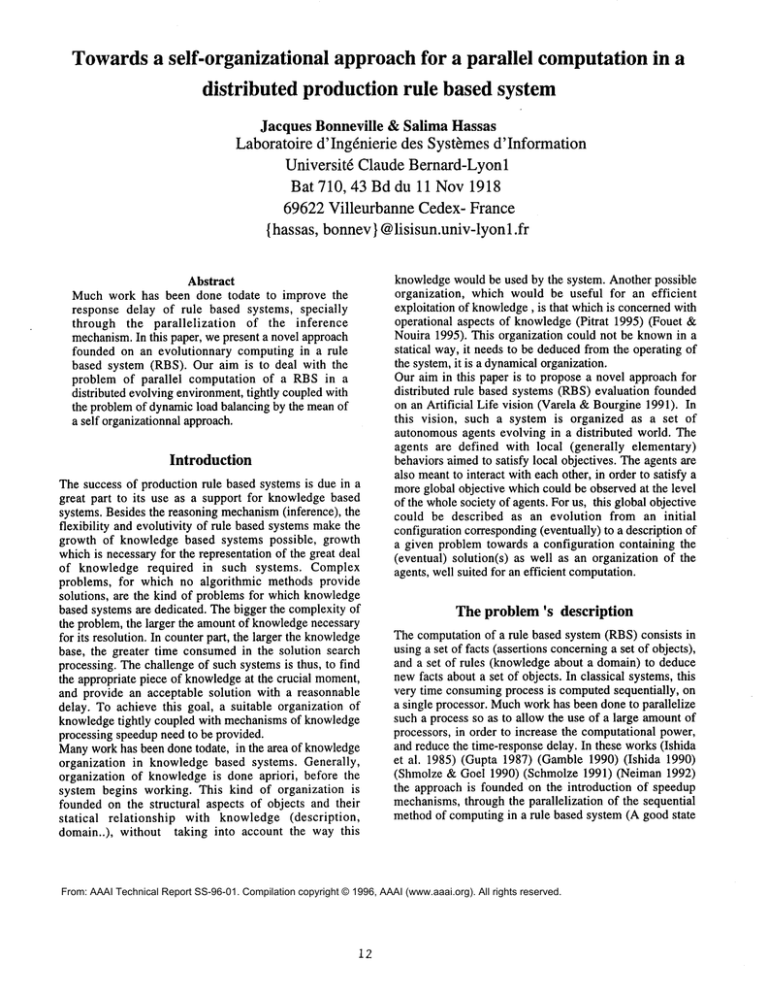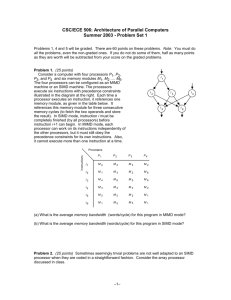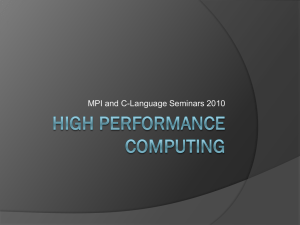Towards a self-organizational approach for a parallel ... distributed production rule based system
advertisement

Towardsa self-organizational approachfor a parallel computationin a
distributed production rule based system
Jacques
Laboratoire
Bonneville
& Salima Hassas
d’ Ing6nierie
des Syst~mes d’Information
Universit6
Bat 710,
Claude
43 Bddu 11 Nov 1918
69622 Villeurbanne
{ hassas,
Bernard-Lyonl
Cedex-
France
bonnev } @lisisun.univ-lyonl.fr
Abstract
Much work has been done todate to improve the
response delay of rule based systems, specially
through the parallelization
of the inference
mechanism.In this paper, we present a novel approach
founded on an evolutionnary computing in a rule
based system (RBS). Our aim is to deal with the
problem of parallel computation of a RBSin a
distributed evolving environment,tightly coupled with
the problem of dynamicload balancing by the meanof
a self organizationnal approach.
Introduction
The success of production rule based systems is due in a
great part to its use as a support for knowledgebased
systems. Besides the reasoning mechanism(inference), the
flexibility and evolutivity of rule based systems makethe
growth of knowledge based systems possible, growth
whichis necessary for the representation of the great deal
of knowledge required in such systems. Complex
problems, for which no algorithmic methods provide
solutions, are the kind of problems for which knowledge
based systems are dedicated. The bigger the complexity of
the problem, the larger the amountof knowledgenecessary
for its resolution. In counter part, the larger the knowledge
base, the greater time consumedin the solution search
processing. The challenge of such systems is thus, to find
the appropriate piece of knowledgeat the crucial moment,
and provide an acceptable solution with a reasonnable
delay. To achieve this goal, a suitable organization of
knowledgetightly coupled with mechanismsof knowledge
processing speedup need to be provided.
Manywork has been done todate, in the area of knowledge
organization in knowledge based systems. Generally,
organization of knowledge is done apriori, before the
system begins working. This kind of organization is
founded on the structural aspects of objects and their
statical relationship with knowledge (description,
domain..), without taking into account the way this
knowledgewould be used by the system. Another possible
organization, which would be useful for an efficient
exploitation of knowledge,is that which is concerned with
operational aspects of knowledge(Pitrat 1995) (Fouet
Nouira 1995). This organization could not be knownin
statical way, it needs to be deducedfrom the operating of
the system, it is a dynamicalorganization.
Our aim in this paper is to propose a novel approach for
distributed rule based systems (RBS) evaluation founded
on an Artificial Life vision (Varela &Bourgine 1991).
this vision, such a system is organized as a set of
autonomousagents evolving in a distributed world. The
agents are defined with local (generally elementary)
behaviors aimedto satisfy local objectives. The agents are
also meantto interact with each other, in order to satisfy a
more global objective which could be observed at the level
of the wholesociety of agents. For us, this global objective
could be described as an evolution from an initial
configuration corresponding(eventually) to a description
a given problem towards a configuration containing the
(eventual) solution(s) as well as an organization of
agents, well suited for an efficient computation.
Theproblem’s description
The computation of a rule based system (RBS)consists
using a set of facts (assertions concerninga set of objects),
and a set of rules (knowledge about a domain) to deduce
newfacts about a set of objects. In classical systems, this
very time consumingprocess is computedsequentially, on
a single processor. Muchwork has been done to parallelize
such a process so as to allow the use of a large amountof
processors, in order to increase the computational power,
and reduce the time-response delay. In these works (Ishida
et al. 1985) (Gupta 1987) (Gamble 1990) (Ishida
(Shmolze & Goel 1990) (Schmolze 1991) (Neiman
the approach is founded on the introduction of speedup
mechanisms,through the parallelization of the sequential
methodof computingin a rule based system (A good state
From: AAAI Technical Report SS-96-01. Compilation copyright © 1996, AAAI (www.aaai.org). All rights reserved.
12
of the art of this kind of parallel production systems, is
given in (Kuo & Moldovan1992) (Abtroun 1995)).
In our workwe are interested in two points: first, we have
to propose a model for a parallel computation in a RBS
with a large exploitation of parallelism, by means of
interactive autonomous agents; second, we suggest an
approach which allows to take into account the
organization of these agents around the problemstructure.
This organization is intended to give an answer to the
following questions:
Example : the fact POSITION
(o, 123)
expresses that the object o has the position 123
and is represented by:
Object: o
Attributes:
( POSITION
( value 123))
how could the interactive
agents be distributed
dynamically on a set of processors, so as to shorten the
delay of communications without increasing
the
processors’ loading?
how could this distribution take into account the
evolving features of a knowledgebased system: newrules,
newobjects, movingrules and/or objects ?
could we discover relationships between objects, rules
related to the way they could be used efficiently by the
system and create new hierarchies of objects following
their use by the system (not following their structure
anymore)?
which associates the attribute POSITION
to the object
o with the value 123.
To answer these questions, a parallelization founded on a
classical approach of a rule based system evaluation could
not be satisfying, since in this approachthe affectation of
objects on the various processors is done in a statical way,
and no work done todate does take into account the
problem of the dynamicevolution of a rule based system,
neither does it consider the dynamic load balancing
problem of such systems (Kuo & Moldovan1992).
Principles of our approach
In our approach the computation in a rule based system is
viewed as a set of autonomous agents, evolving in a
distributed world and interacting with one another, in order
to increase a local satisfaction function. A simplified vision
of the system’s computationcould be to consider rules and
values used in the inference mechanismsas autonoumous
agents whose behavior is looking for food. An object
consumes rules firing (when a value contributes to the
firing of a rule, it is rewarded by increasing its local
satisfaction function) and a rule consumes successfull
pattern-matchings with a variable. The agents have in
charge beside this, to find food (rewarding rules for
example) and interesting localizations (places with many
similar agents for example) by interaction with each
another.
Context
Weconsider a knowledge based system using production
rules of the first order logics, operating with forward
chaining mechanism.In our context, rules and values are
represented by objects, predicates are represented by
attributes asociated to objects.
13
To fire a rule, we need to find a set of objects whosevalued
attributes do satisfy the left hand side (LHS)of the rule.
Since rules and objects are distributed amonga set of
processors, and since their localization is meantto evolve
during the system’s evolution (dynamic affectation and
load balancing..), it does not seemrealistic to develop
system of communication between agents, based on a
name-addressing mechanism.
So in this environment,each agent (rule, object, other..) has
to evolve by interacting with other agents, in order to find
rewardingplaces to go to (places with interesting rules to
consume,for example).
Modelization:Rules, objects and schemas
The modelization we propose concerns two aspects: the
first one is to achieve a parallel computation in a
distributed RBS,through interaction between agents; the
secondis to exploit the interaction describing the activity
of agents to achieve a suitable repartition of rules and
objects amongprocessors. Besides the evaluation, the final
objective is to find a mappingof the rules/objects on the
processors whichsatisfies (dynamically) the following:
¯ highly interacting objects/rules as well as similar objects/
rules tend to create nearly independantregions (clusters)
¯ objects/rules which are active at the sametime share the
computationressources (processors) in a balanced way;
Modelization of the computation (rule firing).
consider the following rule
R:
Let us
A(x,y) and B(y, z) and C(x,z) ==>D(x,y,z)
To fire R, we need to have 3 objects ol, o2, o3 satisfying
the following : ol has the attributes A and C with the
respective values 02 and o3, and 02 has the attribute B with
the value 03.
Fromthe point of view of the rule, to get a chance to be
fired, R needs to find objects (x,y,z) (similar to (ol,
03)) where x has the attributes (A(y) C(z) ) and y
attribute (B(z)). (notice that the value z appearing in
the sameas the one appearing in B).
Wecall (A(y) C(z) ), x_schema of t he rule R, an d
(B(z)) y_schema. Moregenerally, we as sociate with
each rule as many schemas as the number of variables
leading the premisses of its LHS.
Fromthe point of view of the objects, an object needs to
find rules interested by its valued attributes, for example
when ol, proposes the schema((A 02) (B o3)), this
interests the rule R.
So to each object, we associate a global schema
correspondingto the set of its valuedattributes.
Wemodelize the problem of rule firing by an interaction
between two kinds of agents: a rule_agent which looks in
the distributed environment for objects satisfying a
rule_schema, and an object_agent whose behavior is to
find rules interested by its object_schema. So for the
computation, each rule creates rule_agents , where each
agent is associated with each of its schemas, and in counter
part, each object creates an object_agent.
The behavior of each rule_agent (resp. object_agent)
to look in the distributed environment,for objects (resp.
rules) with an object-schema (resp. rule-schema) which
unifies the rMe_schema(resp. object-schema). Whenan
object-schema unifies a rule-schema, a link is created
betweenthe object and the rule, and a copy of the objectschemais sent to the correspondingrule, to instanciate the
rule ( the copyof the object-schemais destroyedafter use).
At the same time, each agent, memorizesthe gratifying
rule/object, so as to communicate
the information to similar
agents. The instanciation of a rule with an object creates a
partially instanciated rule (PIR). A PIR has two possible
behaviors: the first one is the same as the behavior of its
generating rule with partially
instanciated
(more
specialized) premisses, the second one consists in making
a join operation with a complementaryPIR (of the same
rule). A complementaryPIR is obtained by instanciation of
the rule by complementaryobjects (cf. example).
Example
The instanciation of rule R, with an object ol, the
schema of which contains (A(o2)) creates
following PIR:
PIRI: B(o2,z) and C(ol,z) ==>D(ol,
the behavior of whichis:
- either to find by interaction an object of kind z;
- or to realize a join operation with a complementary
PIR.
A complementary PIR could result from the
instanciation of rule R, with an object 02, the schema
of which contains (B(o3)):
PIR2: A(x, 02) and C(x, 03) ==>D( x, 02,
The join operation between PIR1 and PIR2 will
produce the complete instanciation of rule R with the
objects ol, 02, 03.
14
Interactions
between agents. We observe in this
modelization,the following kinds of interactions:
¯ rule-obiect interaction: this interaction takes place
between a rule_agent and an object_agent, to achieve a
pattern-matching between the respective schemas of each
of the agents. Theresult of such an interaction is to create a
link betweenthe object and a rule involved in a successful
unification, and makethe evaluation of the rule with the
object happen. The link created between the rule and the
object is usefull for the repartition problem.
¯ object-object interaction: this interaction takes place
between object_agents, in order to find similarities one
object could have with another. The similarities
are
computedby comparing the objects schemas (for instance
any pair of agents with non empty intersection of their
schemas,are considered to be similar). Whena similarity is
found between two agents, they proceed to an exchange of
information such as gratifying rules to visit, creation of
links betweensimilar objects..etc.
¯ rule-rule interaction: this interaction takes place between
rule_agents, in order to find similarities betweenrules in
the same way as the objects do, and the agents proceed to
the same kind of exchangeof information the objects do.
¯ IPR-IPRinteraction: this interaction takes place between
the IPRs of a same rule in order to find complementary
IPRs, and makes them join.
Modelization of the objects/rules
repartition.
As seen in the previous section, links are created through
the agents’ interactions betweensimilar objects/rules, and
between objects (resp. rules) and gratifying rules (resp.
objects). Theselinks do express the strength of the activity
held by the related objects and rules during the
computation. So, it would be interesting
to have a
repartition of objects/rules which considers the links
created betweenobjects and rules, so as to create groups of
objects and rules, where each group embodiesthe entities
which need to work together during the computation and
for which it is wishable to shorten the delay of
communication.An interesting repartition is that which
mapsa group on a processor or a set of directly connected
processors. But as we could see, it is practically impossible
to do such a repartition statically, since links are created
during the computation. The idea to achieve this, would
then be to let the objects/rules find this organization
themselves through their interactions with each other.
During the computation, when links are created between
entities (object/rule),
each entity proceeds to the
computation of its local satisfaction function to check
whether its current localization is satisfying. The
satisfaction of an entity increases whenit is close to similar
entities or gratifying entities. Whenthe satisfaction of an
entity happensto be better on another processor, it has to
moveto that processor. This migration of entities could
disturb the load balancing of processors. To avoid this,
each processor has the possibility to push the less satisfied
entity onto one of its neighbours, if the load balancing
comesto be disturbed.
IJCAII Workshopon Machine Learning and Engineering.
99-114, Montrral.
The dynamic load balancing problem. Some important
work has been done todate in the area of dynamic load
balancing, specially in the area of supecomputing (as
mentionned to in (Heirich & Taylor 1995)) and machine
learning (Scaerf , Shoaham& Tennenholtz 1995), and
some intersting algorithms has been proposed. In our
work, we view the dynamic load balancing as a
consequence of the confrontation
of two opposite
objectives
of computing agents: similar agents
(objects/rules) tend to create a concentration around
processor (or a set of close processors), whenthey try
be close to each other., and the processor (or a set of close
processors) try to maintain its loading to a satisfying
threshold. The action of agents migration produces a
concentration of similar agents from a wide dispersed set of
processors, to a smaller area of closely distributed
processors. The reaction of the processor (set of
processors), to the problemof contention, is to avoid it by
diffusing progressively agents so as to widen the
contentioned region to its nearest neighbourhood. To
achieve this action/reaction
mechanism, an approach
based on micro-economics (Wellman 1995), could
interesting. Actually, the ongoiing tests are based on the
simplistic description given above.
Gamble, R.F. 1990. Transforming rule based programs
from the sequential to the parallel. In Proceedingsof the
Third International
Conference on Industrial
and
Engineering Applications of Artificial Intelligence and
Expert Systems, 854-863. Charlton, South Carolina.
Gupta A. 1987, Parallelism in Production Systems, Pitman
publishing.
Heirich, A., Taylor, S. 1995. A barabolic loadin balancing
method. In Proceedings of the International Conferenceon
Parallel Processing.
Ishida, T., et al. 1985, Towardsthe parallel execution of
rules in production system programs. In Proceedings of
1985 International Conferenceon Parallel Processing,
568-575.
Ishida, T. 1990, Methodsand effectiveness of parallel rule
firing. In Proceedingsof the sixth International Conference
on Artificial Intelligence Applications, Washington,DC.
Kuo, S.; Moldovan
D. 1992, The State of the Art in Parallel
Production Systems, Journal of Parallel and Distributed
Computing,15, 1-26.
Neiman, D.E. 1992. Design and control of Parallel RuleFiring Production Systems. Ph.D. diss., Dept. of Computer
Science, Univ. of Massachusetts.
Conclusion
We have presented
a novel approach,
based on
evolutionnary computing, which we believe is promizing to
deal with the parallel computation in a distributed rule
based sytem, in an evolving distributed environment.
In such an environment, it is difficult to have a statical
repartition of entities of the system coupled with an
addressing mechanism,since the interaction between the
entities is not known a priori. Webelieve that our
approach, based on a computation through interaction
could be an interesting begining to systems which try to
solve a problem and find an organization of their
componentsadapted to the problemresolution.
Actually, a plateform of interacting agents has been
implementedand simulation algorithms are being tested,
specially concerning the problem of repartition and load
balancing, so as to evaluate the efficiency of such an
approach.
Pitrat, J. 1995, Implementationof a reflective system.
In Proceedings of the IJCAII Workshop on Machine
Learning. Montrral.
Schaerf, A., Shoam, Y., Tennenholtz, M. 1995, Adaptive
Load Balancing: A study in Multi-Agent Learning, Journal
of Artificial Intelligence Research,2(1995), 475-500.
Schmolze,J.S. 1991. Guaranteeing serializable results in
synchrounous parallel production systems, Journal of
Parallel and Distributed Computing,13 (4), 348-365.
Schmolze J.S.; Goel S. 1990. A parallel asynchrounous
distributed production system. In Proceedingsof the Eighth
National Conference on Artificial Intelligence, 65-71,
AAAI-90, Boston, MA.
Varela F.J and Bourgine P., eds, 1991, Proceedings of
First EuropeanConferenceon Artificial Life, Paris.
References
Abtroun, M.A. 1995. Etude du probl~me du contr61e dans
les syst~mes ~ base de r~gles parall~les. Mrmoirede DEA
LISI, Universit6 Claude Bernard-LyonI. (in french)
Fouet, J-M., Nouira, R. 1995. Acquiring and structuring
knowledge using metaknowledge. In Proceedings of the
15
Wellman, M.P. 1995, Market Oriented Programming:
Someearly lessons. In S.H. Clearwater (ed.). MarketBased
Control: A paradigmfor distributed ressources allocation.
WorldScientific.




